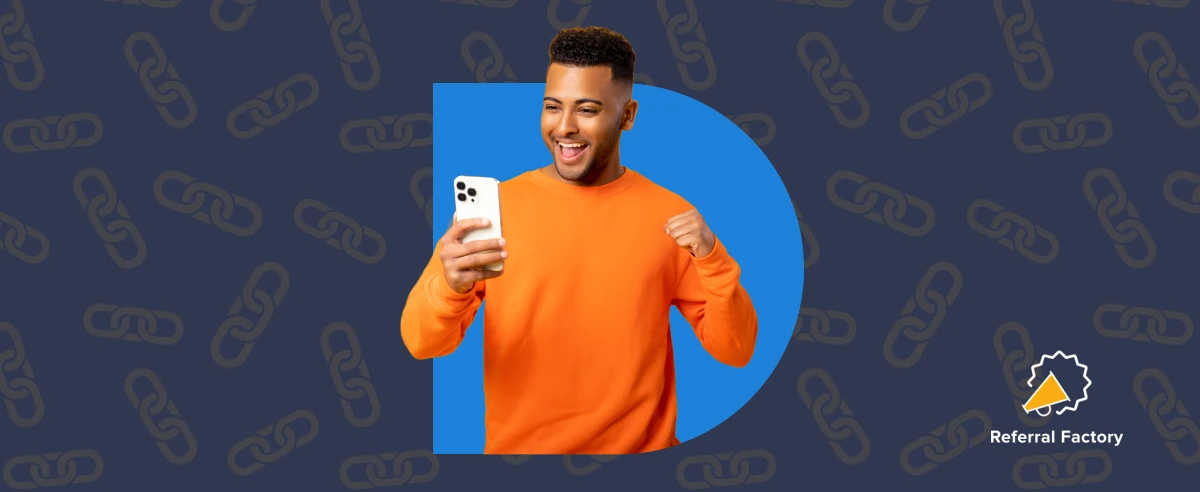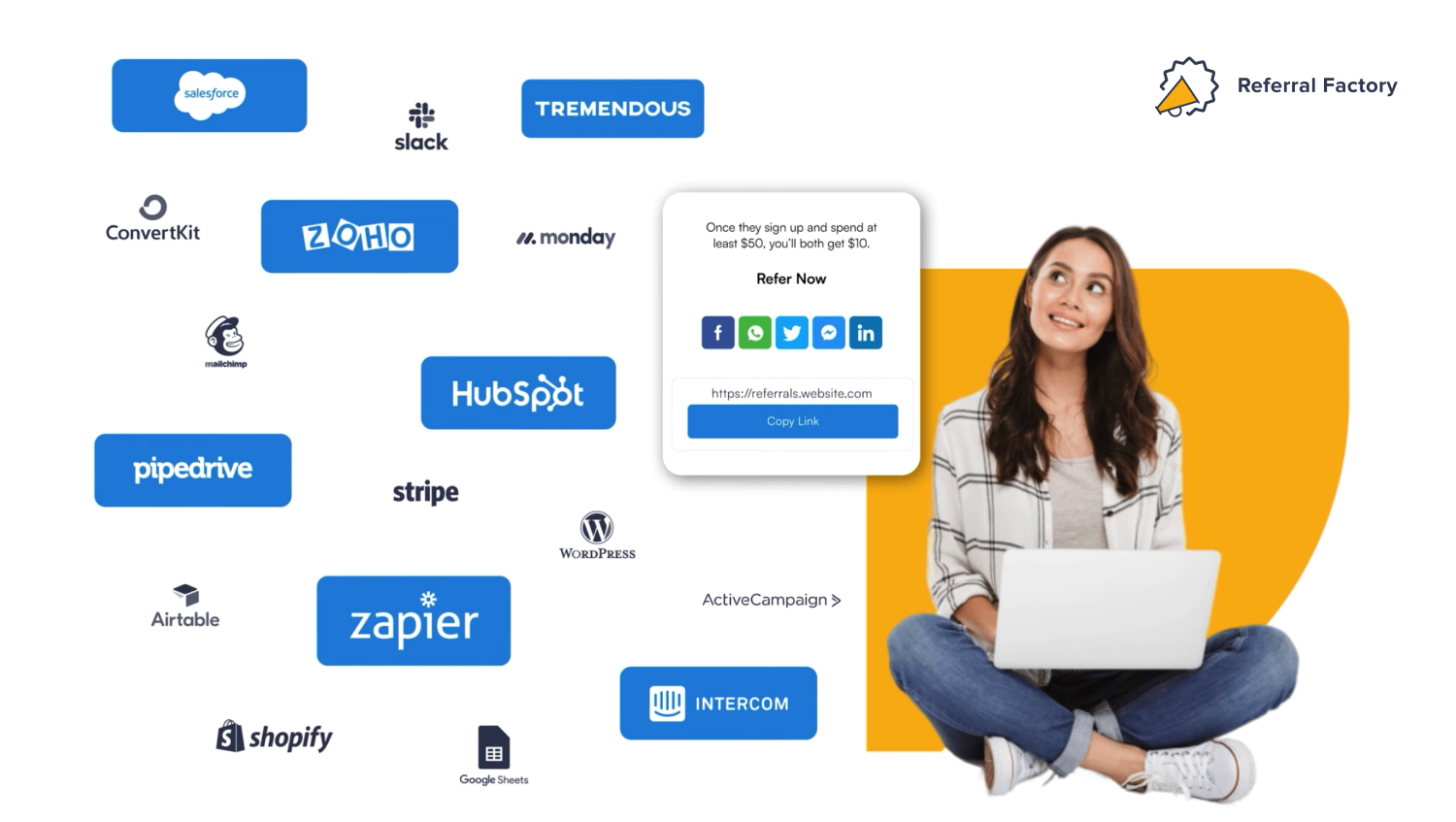What Is A Referral Link and How To Create One
Key takeaways:
- A referral link is a unique URL that tracks customer referrals and rewards advocates.
- Referral marketing builds trust and attracts high-quality customers who are more likely to stay.
- Businesses can quickly set up referral programs using no-code software.
- Offering incentives encourages customers to actively promote a brand.
- Referral-driven customers often have higher retention and engagement than those from paid ads.
Spanish version ¿Qué es un enlace de referencias y cómo crear uno?
A referral link is a unique URL that helps businesses track and reward people who bring in new customers. Instead of relying solely on ads, businesses can encourage their existing audience to spread the word, leading to higher-quality leads and stronger customer loyalty.
When a customer shares their referral link and someone clicks on it, the business can see where the new customer came from. This makes it easy to reward referrers with discounts, cash, or perks. Since people trust recommendations from friends more than ads, referral-driven customers tend to be more engaged and stick around longer.
With modern referral software, setting up a referral program takes minutes. Businesses of all sizes can use it to drive growth, turning satisfied customers into their most effective promoters.

Table of Contents
What is a referral link?
A referral link is a unique URL that tracks and attributes new customers to the person who shared it. Businesses use these links to identify which users are bringing in referrals and reward them accordingly. Each link contains tracking parameters that help businesses measure referral program performance and optimize their strategy.
Referral links are easier to use than codes because they don’t require manual entry. When someone clicks a referral link, the system automatically tracks their action. This makes the process seamless for both the referrer and the new customer.
The role of referral links within a referral program
Referral links are the core of any referral program. They ensure businesses can accurately track referrals without relying on manual reporting. Businesses can generate unique links for customers, employees, affiliates, or partners and assign rewards based on performance.
A well-structured referral link system helps businesses scale their referral programs without added complexity. Businesses can customize links with tracking parameters, direct users to specific landing pages, and personalize messaging. This improves engagement and increases the likelihood of successful referrals.
Why use referral marketing?
Referrals work because they are built on trust. When someone shares a referral link, they are vouching for the brand, and their recommendation carries more weight than traditional advertising. Studies show that people trust recommendations from friends and family far more than company promotions.
Referred customers are also more likely to stay. According to Deloitte, customers acquired through referrals have a 37% higher retention rate. This makes referral marketing one of the most reliable ways to grow a loyal customer base.
By making it easy for customers to share referral links, businesses can tap into this trust-driven marketing channel, bringing in high-quality leads who already have confidence in the brand.
How do referral links work?
Referral links are unique URLs that help businesses track and reward people who bring in new customers. When someone shares their link and another person clicks on it and completes an action—like signing up or making a purchase—the system records that as a successful referral. This makes it easy to see who is helping bring in new customers and reward them accordingly.
These links work by embedding tracking codes that are linked to the person who shared them. This data allows businesses to monitor the performance of their referral programs, see which referrers are bringing in the most valuable customers, and adjust their strategy based on real insights.
The importance and benefits of using referral links
Referral links are a simple but effective way for businesses to grow through word-of-mouth marketing. They offer several advantages over traditional marketing methods, making them an important tool in any referral program.
Here’s how referral links can benefit your business:
- Accurate tracking. Referral links give businesses clear data on who is referring customers, making it easier to track and reward participants.
- Better quality customers. People are more likely to trust recommendations from friends than ads. This leads to customers who are more engaged and likely to stick around.
- Cost-effective growth. Referral links let you tap into your existing customer base to drive new leads, reducing the need for expensive advertising.
- Simple process. Referral links don’t require customers to remember or enter codes, which makes the process easier for everyone involved.
- Valuable insights. With referral links, businesses can track important metrics like clicks, conversions, and top referrers, giving you the data to improve your strategy over time.
Referral links make it easier to track, share, and reward referrals. They help businesses grow without complicated processes or big marketing budgets.
How to create a referral link in two ways
Essentially, you just need to generate a unique link that your customers can share with their friends. This link will take their friends to a landing page where they get introduced to your brand, and in many cases get offered something special to become a customer of yours too.
When the friend of your customer (referrer) fills in their information on the link and then continues on to make a purchase, book a demo, subscribe, or take whatever action you deem to be a converted referral, the referrer gets a reward. This could be a voucher, cash, a discount, a free product, or anything else.
Brands can have one or multiple referral programs. They can also use different tracking methods like referral codes or a unique referral link.
Let’s look at the different ways you can create these referral links.
1. Use referral program software to create your referral links
One way to create a referral link is to use referral software like Referral Factory. This no-code solution makes it easy to set up a referral program for your business, and even easier to create a unique referral link for each of your customers or affiliates. Your customers can either register to refer or you can upload your customers to your referral program, or you can sync your CRM contacts to your referral program, or you can add your customers to your program via Zapier or API.

When it comes time to reward your customers for successfully referring new business your way, you can either issue your own rewards or opt to use one of the 200+ gift card and cash options offered through Referral Factory. This referral program software will also handle all the tracking for your referral program, allowing you to see who referred who, which of your referrals converted, and who your top referrers are (everything ties back to the referral code inside their unique referral link).
You can see all of this in one simple-to-understand analytics dashboard.

2. Hire developers to create and manage each referral link: Step-by-step
If you want to create a referral link without using referral software, it is possible it just takes a few more steps and you should be an advanced technical marketer to try this method. This method is more recommended for marketers who want to create multiple referral programs at scale, and need tight control of the design and technical aspects. Here are the steps:
Step 1. Build your customer referral program: Work with your developers to create all the pages for your referral program, share options, email notifications, user tracking, and more – you’ll need to invest sufficient time getting this ready as everything is created from scratch. You’ll need to also create your referral code base logic and generate the html pages for your referral link pages.
Step 2. Assign a unique referral link for each of your customers: your developers should have built a system that auto generate a URL for each customer, you then use a URL shortener (such as bit.ly) to create a unique link or (using a referral code) that customers can easily share with their friends.
Step 3. Add unique GTM tracking parameters to each user’s link: To track the success of your referral program, you’ll want to add tracking parameters to each individual link. You’ll also then need to set up specific goals on your Google Analytics that track what a conversion for your referral program is. This will allow you to see how many clicks and conversions each referral link is generating. It’s important to note that these tracking params are simply connecting tracking an event, you will still need to tie each event to the referral code of a user.
Step 4. Offer a reward: To incentivize your customers to share your referral link, offer them a reward for each successful referral. This could be a discount, free product, or other incentive that makes them excited to spread the word about your business. You’ll need to issue these manually if you aren’t using referral software that automates the process.
If you code a referral link system yourself, expect to invest significant time and resources. Building a program from scratch requires extensive development and testing, making it best suited for complex referral programs that off-the-shelf software can’t support.
Creating referral links is a simple way to grow your business. Whether you use referral software or build links manually, promote them and encourage customers to share. When customers refer others, they vouch for your brand, making referrals a powerful marketing tool.
How to track referral links
Tracking referral links helps businesses measure performance and reward referrers accurately. Without proper tracking, it’s difficult to know which referrals convert and who should receive incentives. There are two main ways to track referral links: manually or through automated tools.
Manually tracking referral links
Manual tracking involves collecting and reviewing referral data without specialized software. Businesses can track referrals by assigning unique URLs to each participant and monitoring clicks, sign-ups, or purchases in analytics tools like Google Sheets or CRM systems. This method requires ongoing data entry and validation to prevent errors.
For businesses with a small number of referrals, manual tracking can work. However, it becomes inefficient as referral programs grow. Keeping records up to date and verifying conversions takes time, increasing the risk of missed or inaccurate data.
Automated referral link tracking
Automated tracking simplifies the process by using referral software to generate, track, and manage referral links. These platforms automatically attribute referrals to the correct users, track conversions, and generate reports.
With automation, businesses can see real-time data on clicks, shares, and successful referrals. Many tools integrate with CRM and marketing platforms, making it easier to manage large-scale programs without manual oversight. Automated tracking ensures accuracy and saves time, allowing businesses to focus on optimizing their referral strategy.
Why you should use referral links and not referral codes
When it comes to setting up a referral program, there are a few different options to consider. Make sure you do your research find the best refer a friend program strategy for your business!
One popular method is to use referral codes, which are unique codes that customers can share with their friends to earn rewards. However, there is a better option available: referral links.
Referral links work by providing each of your referrers with a dedicated landing page to invite their friends to your business. This landing page is customized specifically for the referrer, making it easier for them to promote your business and track their referrals. These landing pages also allow you to create ‘offers’ that your customers can share with their friends to accept or unlock.
Referral link > page > offer
Or
Page > offer > referral code
Here are some examples of this:


Compared to referral codes, a referral link offers several advantages. For one, they provide a more streamlined experience for both referrers and their friends. Referrers don’t have to worry about remembering and sharing a code, and their friends can simply click on the referral link to visit your site and make a purchase.
In addition, referral links make it easier to track and reward successful referrals. With a dedicated landing page for each referrer, you can easily monitor how many referrals they’ve made and what referral rewards they’re eligible for. Using a referral code cannot give you these kinds of benefits.
Another reason it’s a smarter choice to use referral links over referral codes is so that you can see the exact reach of each person’s referral links. Tracking codes is almost impossible as you only know a code has been shared once the person that was referred uses the code on checkout. But with a referral link you can track these metrics for each referrer: reach, referrals, and converted referrals.

As you can see, referral codes might be easy for people to share, but they lack the tracking abilities you need to really scale your word-of-mouth efforts.
Overall, using a referral link for each person is a smart choice for any business looking to grow through word-of-mouth marketing. By providing your customers with an easy way to share their referral link for your business, you can essentially generate new referred leads that arrive at your business already trusting your brand.
Can I also create a referral link for an affiliate?
Yes, you can use the same method to make referral links for customers, affiliates, or employees that might want to refer their friends to your business too. The beauty about building a referral program is that you can use it to manage the referral process for more than one type of referrer. In fact, using referral software to create affiliate links can be a very cost-effective solution because you can run referral programs targeted at different types of advocates from the same place! You can generate referral codes in bulk, and set up comprehensive tracking of each users referral link.
You can invite influencers and brand ambassadors to join your referral program – as it will streamline the tracking process so that you can see how many referrals they generate, and how many of those referrals convert.

What’s the difference between a referral link and an affiliate link?
While both referral and affiliate links are designed to track and reward people for bringing in new customers, the main difference lies in their use cases. Referral links are typically used in programs where customers or employees refer others they know, often as a casual part of their engagement with a brand.
Affiliate links, on the other hand, are often used by individuals or companies who actively promote a brand as part of a formal partnership or business arrangement. Affiliates may receive commissions for sales or leads generated through their links. While referral links can be part of a broad program with various types of participants, affiliate links are generally tied to a more structured compensation plan.
What channels can customers share a referral link on?
Referrals often happen largely in dark social environments, this is because users send their referral links to their friends directly, not via public social media channels. Data from Referral Factory shows that the most popular channels users share their referral link on are:

Sharing their referral links is a crucial step for your customers to take if they want to actively refer business your way, and get rewarded for doing so.
Here are some tips you can give to your customers about how to share their referral links:
- When sharing your referral link, it’s important to provide some context around why someone should use it. Explain the benefits of your product or service and how it can help the person you’re sharing it with. Don’t be afraid to get personal and share your own experience using the product or service.
- Another effective way to share your referral link is through word-of-mouth. Talk to your friends, family, and colleagues about your business and ask them to share your referral link with their own networks.
- Share your referral link across all your social media channels – by using social media, you can spread the word about our business to all of your followers, and ultimately drive more referrals in exchange for rewards. So, get creative, be personal, and start sharing your referral link today!
Remember that your customers are just as new to referral marketing as you are, so take the time to educate and help them be successful. Try skip the jargon too, ask them to spread the word, not their referral codes!
When they win, you win.
Best platforms to share referral links
Referral links can be shared on a variety of platforms, depending on what feels most natural for your customers. Here are some of the best options:
- Social media: Platforms like Facebook, Instagram, Twitter, and LinkedIn are ideal for sharing referral links. Customers can post the link to their stories, feeds, or private groups to reach a larger audience.
- Email: Sharing a referral link through email is a personal, direct way to reach friends and family. It allows customers to explain why they recommend the business and add a personal touch.
- Website: Adding a referral link to a website or blog is another great way to attract referrals. It can be integrated into customer testimonials or embedded in content.
- SMS: Text messages are a fast and effective way to send referral links. They’re ideal for personal referrals, as text messages are often more immediate and likely to be seen.
Each platform has its strengths, and the best one will depend on the customer’s preferences and habits. Encouraging them to choose the platform that feels most comfortable will help boost referral engagement.
Are there any potential pitfalls when creating a referral link?
Yes, there are a few common pitfalls when creating referral links that can impact your program’s success. One of the biggest mistakes is not properly tracking and attributing referrals. Without reliable tracking, both referrers and businesses can get confused about who deserves rewards. It’s essential to use referral program software to ensure accurate tracking and fair attribution.
Another common issue is unclear instructions or lack of incentives. If people don’t know exactly how to refer or what they’ll get in return, they’re less likely to participate. Be sure to outline the referral process and make the rewards appealing. And remember, outdated or irrelevant rewards, like those golf shirts from 2017, won’t motivate anyone to share a referral link.
Finally, it’s crucial to avoid being overly aggressive when promoting your referral program. Constantly bombarding customers with reminders or unsolicited messages can turn them off. Focus on respectful, targeted outreach, such as offering the program to customers who are already engaged with your business. This approach will help build confidence and encourage more shares.
Below we’ve aggregated a list of tools you can use to generate referral links or referral codes for your program—these tools are ranked by review scores on independent platforms.

Common mistakes businesses make & how to avoid them
- Poor tracking and attribution: Without accurate tracking, it’s hard to reward the right referrers. Use reliable software to track and attribute referrals properly.
- Unclear instructions or weak incentives: If customers don’t know how to refer or what they’ll get, they won’t participate. Make the process simple and rewards attractive.
- Over-promoting the program: Bombarding customers with constant reminders can backfire. Promote your program thoughtfully to those most likely to refer.
Avoid these mistakes to create a more effective and engaging referral program.
Wrapping up
Referral links are a powerful tool for driving business growth by leveraging the trust and connections of your existing customers. When set up correctly, they allow you to track, reward, and engage your customers in a way that benefits everyone. By avoiding common pitfalls like poor tracking, unclear instructions, and over-promotion, you can create a referral program that’s simple, effective, and scalable. Ultimately, a well-executed referral program turns your customers into valuable advocates, helping you grow your business with minimal cost and effort.




